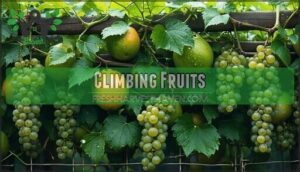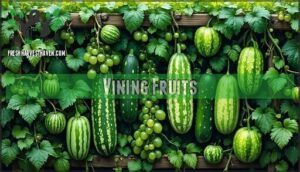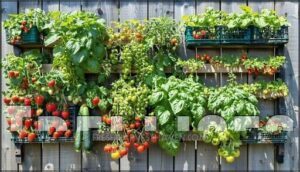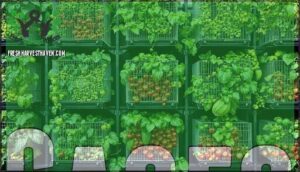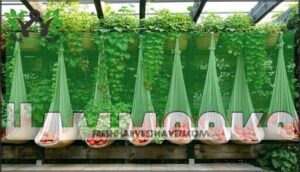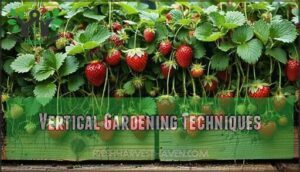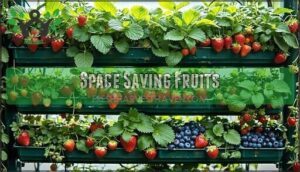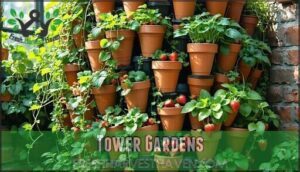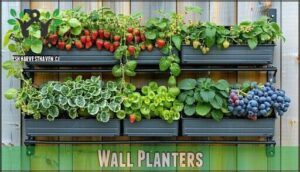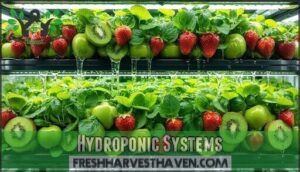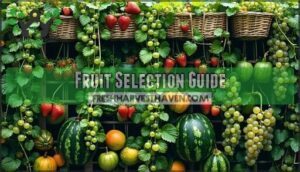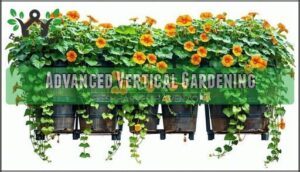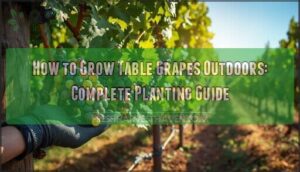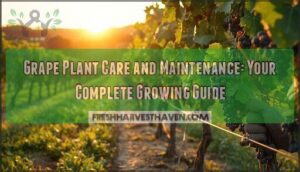This site is supported by our readers. We may earn a commission, at no cost to you, if you purchase through links.
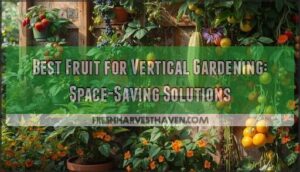
You’ll maximize your harvest with vining fruits like cucamelons and small melons using sturdy trellises.
Climbing options such as hardy kiwi and passion fruit transform bare walls into productive spaces.
Dwarf citrus trees work well in tall containers, while trailing nasturtiums add edible flowers to your vertical setup.
Choose determinate tomato varieties and compact pepper cultivars for consistent yields.
The secret lies in matching fruit types to your support system—some fruits need hammocks for heavy produce.
Table Of Contents
- Key Takeaways
- Vertical Gardening Basics
- Climbing Fruits
- Vining Fruits
- Fruit Support Systems
- Vertical Gardening Techniques
- Space Saving Fruits
- Vertical Garden Designs
- Fruit Selection Guide
- Advanced Vertical Gardening
- Frequently Asked Questions (FAQs)
- What fruits and vegetables are best for a vertical garden?
- What is the easiest fruit to grow on a patio?
- What is the best vegetable to grow on a trellis?
- How many fruits & vegetables can you grow vertically?
- What fruits can you grow in a small garden?
- Which vegetables can be grown vertically?
- Can vine vegetables grow in a vertical garden?
- Can vegetables grow vertically on a trellis?
- What is a vertical vegetable garden?
- What fruit grows vertically?
- Conclusion
Key Takeaways
- Choose climbing varieties for maximum space efficiency – You’ll get the best results with kiwi vines, grapes, and passion fruit that naturally scale upward, plus vining options like cucamelons and small melons that transform walls into productive growing areas.
- Match fruit weight to proper support systems – You’ll need sturdy trellises for heavy grapes, protective cages for delicate berries, and fabric hammocks for weighty melons to prevent structural collapse and stem damage.
- Focus on compact and dwarf varieties for containers – You’ll maximize yields with strawberries in hanging baskets, dwarf blueberries in stacked planters, columnar raspberries, and dwarf citrus trees that thrive in vertical setups.
- Start with easy-growing options before advancing – You’ll build confidence with naturally climbing cucumbers, cascading strawberries, and compact berry varieties before tackling more complex fruits that require specialized pruning and training techniques.
Vertical Gardening Basics
You’ll transform limited spaces into productive fruit gardens by growing upward instead of outward.
Vertical gardening techniques allow you to cultivate fresh fruit in containers, on trellises, and against walls while maximizing every square foot, using vertical gardening to grow fresh fruit.
Maximizing Space
Small spaces don’t have to limit your fruit gardening dreams. Vertical gardening transforms balconies and compact yards into productive growing areas by utilizing upward space rather than expanding outward.
A key aspect of this is to guarantee efficient drip irrigation for your plants.
- Balcony gardens maximize limited square footage through stacked containers and wall-mounted planters
- Urban gardening solutions include tower systems that grow multiple plants in minimal floor space
- Small yards benefit from trellis systems that support climbing varieties against fences or walls
- Container fruits allow flexible positioning and easy relocation for ideal growing conditions
- Layered planting creates multiple growing levels, dramatically increasing your harvest potential per square foot
Increasing Yield
Efficiency transforms your vertical garden into a fruit production machine through strategic planning and optimized techniques.
Maximize harvests by implementing these proven methods:
- Pollination strategies guarantee cross-fertilization for space-saving fruits like kiwi and passion fruit
- Companion planting boosts garden yield maximization while optimizing watering schedules
- Pruning techniques combined with nutrient management increase vertical fruiting potential substantially
These approaches deliver exceptional fruit production results.
Reducing Pest Risk
Vertical gardening fruits dramatically reduce pest problems through elevated structures that improve air circulation around plants.
You’ll find fewer soil-dwelling insects when plants grow above ground level, while beneficial insects access your crops more easily for natural pest control.
This strategic approach enhances garden pest prevention and plant disease prevention without relying heavily on organic sprays or complex companion planting schemes, which supports natural pest control.
Climbing Fruits
Climbing fruits transform vertical walls into productive growing spaces with their natural tendency to scale upward.
You’ll find these vigorous vines produce substantial harvests while requiring minimal ground space, making them perfect for small gardens or urban balconies with a natural tendency to scale upward.
Kiwi Fruit
Kiwi vines reveal remarkable vertical potential when you master their climbing nature and specific needs.
These vigorous climbing vines require strategic planning for maximum productivity in compact spaces.
- Hardy kiwi varieties like ‘Ananasnaya’ produce grape-sized fruits without fuzzy skin, perfect for small gardens
- Male and female plants must be paired correctly – one male pollinator supports up to eight female vines
Choose appropriate kiwi varieties based on your climate zone.
Support structures need exceptional strength since mature vines carry substantial weight.
Install sturdy trellises or pergolas before planting.
Pruning methods involve winter dormant cuts and summer training to control growth.
Fruiting requirements include cross-pollination and patience – most kiwi berries appear after three years of establishment.
Passion Fruit
Passion fruit vines transform vertical spaces into tropical paradises with vigorous climbing fruit plants.
These tropical vines require warm Climate Needs and sturdy fruit trellis systems for ideal growth.
Hand Pollination Tips boost yields during peak Fruiting Season.
Regular Pruning Methods control sprawling growth, while adequate Container Size supports root development.
For optimal growth, consider watering and sunlight requirements.
You’ll harvest aromatic gems from compact vertical gardening setups.
Grapes
With grape varieties like Concord and Niagara, you’ll create productive vertical vineyards in minimal space.
These grapevines naturally climb fruit trellis systems, requiring 6-8 hours of sunlight needs for ideal growth.
Trellis design supports heavy clusters while pruning grapes controls size and enhances fruit quality.
Climbing fruit plants like grapes maximize vertical gardening potential, delivering abundant harvesting grapes rewards from compact growing areas.
Vining Fruits
Vining fruits like cucumbers, cucamelons, and melons transform your vertical garden into a productive powerhouse that climbs skyward instead of sprawling across precious ground space.
You’ll discover these natural climbers produce impressive yields while their trailing vines create living green walls that maximize every square foot of your growing area, making them a great addition to any vertical garden with impressive yields.
Cucumbers
Cucumbers excel in vertical gardening, doubling your harvest while saving precious ground space. These vigorous climbers reward proper support with straighter, cleaner fruits.
- Select vining cucumber varieties like ‘Suyo Long’ or ‘Marketmore 76’ for ideal trellis support
- Install sturdy frameworks before planting to handle mature vine weight
- Apply proper pruning methods by removing lateral shoots for better airflow
- Monitor for pest control since elevated plants simplify inspection and treatment
- Follow harvesting tips by picking frequently to maintain continuous production
To guarantee proper root development, plant them considering appropriate spacing and depth.
Cucamelons
With over a decade of vertical gardening expertise, cucamelons transform small spaces into productive havens.
These vigorous climbers reach 8-10 feet, producing nearly 100 grape-sized fruits per season when trained on sturdy trellises.
You’ll harvest daily after 65-75 days, enjoying exceptional pest control benefits since cucumber beetles rarely bother them.
Growing conditions require full sun and well-draining soil, while companion planting with beans maximizes space efficiency.
Harvesting tips include picking at one-inch size for ideal flavor and texture in your space-saving vertical garden design.
For the best taste, verify fruits reach full size.
Melons
Melons thrive in vertical gardening systems when you select compact varieties and provide sturdy trellis support for their fruit weight.
These space-saving climbers require consistent watering needs and full sunlight exposure to produce sweet harvests.
Choose smaller cultivars under seven pounds for container gardening success, using fabric slings to cradle developing melons on your trellis structure.
Fruit Support Systems
The right support system transforms any climbing fruit into a space-efficient producer that won’t collapse under its own success.
You’ll need to match each fruit’s weight, growth pattern, and climbing style to the appropriate structure—whether that’s a sturdy trellis for heavy grapes, protective cages for delicate berries, or fabric hammocks for weighty melons, which can be a sturdy solution.
Trellises
Wood, metal, and wire mesh offer trellis durability for climbing plants in your vertical gardening setup.
These trellis materials create sturdy frameworks that support heavy fruit loads while maximizing spacesaving potential.
For those looking to purchase, consider available trellis options.
Trellis construction transforms ordinary fences into productive growing surfaces, letting you train fruit varieties upward with confidence and ease.
Cages
Cages offer robust plant support that goes beyond what trellises can provide.
These cage materials – whether galvanized steel, powder-coated metal, or heavy-duty wire – create enclosed support systems that protect your vertical gardening investment.
Cage construction should match your fruit varieties’ mature weight and climbing habits.
Garden cages deliver exceptional cage stability for heavy producers like melons and squash.
Proper anchoring is essential for overall structure longevity.
Fruit protection from wind damage becomes automatic with proper cage size selection.
You’ll find cages particularly valuable for plants that need 360-degree support rather than single-plane climbing surfaces.
Hammocks
Fruit hammocks provide essential support for heavy vining fruits like melons and winter squash. These specialized plant hammocks prevent stem breakage while protecting developing fruits from ground contact and rot.
Hammock Materials range from breathable mesh to sturdy fabric slings that cradle your harvest:
- Choose UV-resistant netting for strawberry plants in hanging baskets
- Install reinforced Hammock Hanging points on trellises or pergolas
- Position slings for ideal Fruit Protection without restricting growth
- Consider Shading Plants beneath hammocks for Garden Relaxation spaces
- Monitor weight distribution as fruits mature in hanging setups
Vertical Gardening Techniques
You’ll master vertical fruit production through three essential techniques that transform cramped spaces into productive harvests.
Proper pruning creates strong frameworks, strategic training guides growth patterns, and optimized soil management guarantees robust root systems that support heavy fruit loads in confined growing areas, utilizing strategic training to ensure the best results.
Pruning
Strategic pruning techniques transform your vertical garden into a fruit-producing powerhouse.
Sharp, clean cuts remove dead branches and redirect energy toward fruit yield.
Focus on crossing limbs that compete for sunlight and nutrients.
This space optimization approach maximizes plant health while preventing overcrowding.
Your compact varieties will reward smart pruning with abundant harvests in minimal square footage.
Training
Proper training transforms wild growth into productive vertical gardens.
You’ll guide climbing fruits using espalier techniques and cordon training to maximize space.
Secure young shoots with soft ties, avoiding damage to tender bark.
Fan training spreads branches horizontally against walls, while upright training directs energy skyward.
Master these pruning techniques early—your vertical supports will thank you later.
Soil Management
Building healthy soil foundations transforms vertical gardens into productive powerhouses.
Container mixes require balanced drainage solutions and organic amendments for ideal nutrient needs.
- Test soil pH regularly – Most space-saving fruits thrive between 6.0-7.0 pH levels
- Layer organic compost – Feed container culture with slow-release nutrients
- Prevent waterlogged roots – Prevent waterlogged roots in small space gardening setups
Space Saving Fruits
You’ll discover that berry crops offer the most productive vertical growing opportunities without requiring extensive horizontal space.
These compact fruit producers adapt naturally to tiered containers, hanging systems, and vertical supports while delivering impressive yields per square foot.
Strawberries
Strawberries excel in vertical gardening setups, delivering sweet rewards in tight spaces.
Day-neutral varieties produce fruit continuously throughout the growing season, making them perfect for hanging baskets and stacked pots.
Alpine strawberries thrive in pocket planters, offering intense flavor despite their petite size.
You’ll love how these compact powerhouses maximize your harvest while keeping maintenance simple.
| Growing Method | Space Efficiency |
|---|---|
| Hanging Baskets | Maximum vertical use |
| Stacked Pots | Tiered production |
| Pocket Planters | Wall-mounted growing |
| Tower Systems | 360-degree harvest |
Blueberries
Anyone who’s tried vertical gardening knows blueberries are champions for cramped spaces.
These compact varieties transform tiered containers and wall-mounted systems into productive berry farms.
Blueberry bushes love acidic soil, making container fruit gardening perfect for controlling pH levels in vertical gardening setups.
- Dwarf blueberry types fit perfectly in stacked planters
- Wall-mounted containers maximize sun exposure for berry production
- Acidic soil requirements are easily managed in controlled containers
- Acid-loving plants thrive when you control their growing environment
Raspberries
Columnar varieties like ‘Joan J’ transform tight spaces into productive raspberry gardening havens.
You’ll maximize vertical supports with these naturally upright canes that need minimal horizontal room.
Pruning techniques involve cutting spent canes after harvest while training new growth upward.
Container fruit gardening works beautifully—just use large pots with excellent drainage.
Pest control becomes easier when raspberries grow vertically, improving air circulation around plants.
These spacesaving fruits deliver exceptional berry quality through summer, making vertical gardening both practical and delicious for urban growers.
Vertical Garden Designs
The secret to successful vertical fruit gardening lies in choosing the right design system that maximizes your growing space while supporting your plants’ specific needs.
Tower gardens, wall planters, and hydroponic systems each offer unique advantages for different fruit varieties and growing conditions, making the choice of system critical to the success of your vertical garden.
Tower Gardens
Tower gardens release incredible growing potential in minimal space. These vertical hydroponic systems maximize production while simplifying maintenance through automated nutrient solutions.
Perfect for growing:
- Hydroponic fruits like strawberries and compact kiwi varieties
- Raspberries in columnar configurations
- Herbs and leafy greens alongside fruit plants
- Vertical aeroponics crops requiring precise system maintenance
Tower materials range from PVC to commercial units, transforming any corner into productive vertical gardening paradise. Consider companion planting strategies to maximize the health of your tower garden plants.
Wall Planters
Wall-mounted containers revolutionize vertical gardening by transforming unused surfaces into productive growing spaces.
You’ll discover endless possibilities for cultivating compact fruits while maximizing your square footage efficiently.
Select appropriate planter materials and mounting techniques to guarantee structural integrity and proper drainage for your fruit wall garden.
Wall-mounted containers require thoughtful irrigation systems and strategic plant selection to thrive.
Consider various container options for your vertical garden.
- Strawberries cascading from tiered pocket planters create living tapestries
- Kiwi berries climbing modular trellis systems against sunny walls
- Compact blueberry bushes nestled in deep rectangular containers
- Aesthetic design elements blending functionality with visual appeal
Proper installation involves securing brackets to wall studs, guaranteeing adequate weight distribution, and positioning containers where they’ll receive the best sunlight exposure for fruit development.
Hydroponic Systems
Hydroponic systems revolutionize vertical gardening by delivering precise nutrient solutions directly to root zones.
These system types include tower gardens and NFT setups that maximize strawberry and kiwi production through environmental control.
Root support structures combined with automation integration create self-managing gardens.
Container culture hydroponics transforms small spaces into productive fruit farms.
Fruit Selection Guide
Selecting the right fruit varieties for your vertical garden requires matching plant characteristics to your specific growing conditions and space constraints.
You’ll need to take into account each variety’s climbing habits, mature size, pollination requirements, and tolerance to your local climate zone before making final planting decisions, considering complete concepts.
Choosing Varieties
Selecting the right fruit varieties transforms your vertical gardening dreams into reality.
Dwarf cultivars like ‘Top Hat’ blueberries and disease-resistant kiwi ‘Issai’ thrive in space constraints while meeting specific sunlight needs and pollination requirements.
- Disease resistance – Choose varieties like ‘Joan J’ raspberries that resist common fungal infections
- Compact growth habits – Select naturally upright blackberries such as ‘Arapaho’ for easier training
- Self-pollinating options – Pick self-fertile cultivars to guarantee fruit production without cross-pollination needs
Climate Considerations
Four key factors determine your vertical fruit gardening success.
Hardiness Zones guide variety selection—hardy kiwi thrives in cooler climates while passion fruit needs warmth.
Microclimates Impact plant performance through Sun Exposure variations and wind patterns.
Regional Varieties adapt to local conditions, making northern region gardening viable with cold tolerant plants requiring proper Frost Protection strategies.
| Climate Factor | Warm Zone Fruits | Cool Zone Fruits |
|---|---|---|
| Temperature Range | Passion fruit, grapes | Hardy kiwi, apples |
| Frost Tolerance | Dragon fruit, figs | Raspberries, currants |
| Sun Requirements | Full sun climbers | Partial shade berries |
| Winter Protection | Minimal covering | Heavy mulching needed |
Soil Requirements
Creating ideal soil conditions transforms your vertical gardening success. Container adaptation requires specialized soil that balances nutrition with drainage efficiency.
Quality container mixes provide the foundation your fruits need:
- Soil pH between 6.0-7.0 guarantees maximal nutrient absorption for most vertical fruits
- Well-drained soil with perlite or vermiculite prevents waterlogged roots in confined spaces
- Soil amendments like compost boost nutrient needs while improving soil structure
Good drainage remains critical since containers retain moisture longer than ground plantings. For best results, consider organic amendments like compost tea to enhance soil fertility.
Advanced Vertical Gardening
Once you’ve mastered basic vertical gardening techniques, you can explore advanced companion plants that enhance your fruit production.
Nasturtiums and sweet potatoes offer unique vertical growing opportunities that complement traditional fruit crops while maximizing your garden’s potential.
Nasturtiums
Nasturtiums transform your vertical space into an edible masterpiece. These trailing plants climb effortlessly up trellises while delivering pest control benefits through companion planting.
Their edible flowers pack a peppery punch perfect for culinary uses. Plant seeds directly in well-drained soil for best results. Growing tips: harvest young blooms regularly to encourage continued flowering throughout the season.
Sweet Potatoes
Beyond nasturtiums, vertical sweet potatoes reveal tremendous growing potential in compact spaces. These vining plants climb trellises effortlessly, producing nutritious tubers while their trailing stems create living walls up to 10 feet tall.
Support structures and proper soil requirements guarantee success:
- Install sturdy trellises capable of supporting 5kg per plant
- Maintain well-draining, sandy soil with pH 5.5-6.5 for ideal growth
- Implement elevated pest management strategies reducing soil-borne diseases by 20%
- Follow harvesting tips for easier tuber access after 90-120 days
Frequently Asked Questions (FAQs)
What fruits and vegetables are best for a vertical garden?
You’ll maximize yields with strawberries in hanging baskets, columnar raspberries against walls, and dwarf citrus in containers.
Climbing grapes, passion fruit, and kiwi vines transform fences into productive spaces while saving ground area.
What is the easiest fruit to grow on a patio?
Dwarf strawberries, compact blueberries, and container citrus trees offer you simple patio success.
These resilient varieties thrive in containers, require minimal maintenance, and you’ll harvest fresh fruit within months of planting, which leads to simple patio success.
What is the best vegetable to grow on a trellis?
Cucumbers dominate vertical trellis gardening, producing heavy yields in minimal space. Their natural climbing habit, rapid growth, and continuous harvest make them perfect for beginners seeking maximum return on investment.
How many fruits & vegetables can you grow vertically?
You can grow dozens of fruits and vegetables vertically!
Strawberries, tomatoes, cucumbers, beans, peas, grapes, kiwi, raspberries, blackberries, herbs, leafy greens, peppers, and dwarf fruit trees all thrive in vertical systems.
What fruits can you grow in a small garden?
Small gardens can accommodate strawberries, dwarf citrus, columnar apples, blueberries, and raspberries. You’ll enjoy compact varieties like ‘Top Hat’ blueberries, dwarf peaches, and alpine strawberries that thrive in containers.
Which vegetables can be grown vertically?
Think vertical and you’ll discover your garden’s hidden potential.
You can train tomatoes, cucumbers, beans, peas, squash, and leafy greens on trellises, towers, or walls for maximum harvest in minimal space.
Can vine vegetables grow in a vertical garden?
Vine vegetables thrive vertically when you provide proper support structures. Tomatoes, beans, peas, and cucumbers naturally climb trellises, while squash and melons need sturdy frameworks to handle their weight.
Can vegetables grow vertically on a trellis?
Many vegetables absolutely thrive on vertical trellises, maximizing growing space while improving air circulation.
Pole beans, peas, cucumbers, and tomatoes naturally climb, making harvesting easier and increasing yields per square foot.
What is a vertical vegetable garden?
A vertical vegetable garden maximizes growing space by training plants upward using trellises, towers, or stacked containers instead of spreading horizontally across ground level.
What fruit grows vertically?
Kiwi vines can climb 20 feet vertically on trellises, producing grape-sized fruits. You’ll also succeed with climbing grapes, passion fruit, raspberries, blackberries, strawberries in towers, and dwarf fruit trees trained upright.
Conclusion
Despite concerns about vertical gardening complexity, you’ll discover it’s surprisingly straightforward with proper fruit selection.
The best fruit for vertical gardening transforms limited spaces into productive harvests.
Your carefully chosen climbing kiwi, cascading strawberries, and compact blueberries will reward you with fresh produce year-round.
Remember that support systems matter—invest in quality trellises for heavy fruits and hammocks for melons.
Start small, learn your plants’ growth patterns, and expand gradually.
You’ve got everything needed to succeed vertically.
- https://pss.uvm.edu/ppp/articles/vertgard.html
- https://content.ces.ncsu.edu/home-vegetable-gardening-a-quick-reference-guide
- https://eattheplanet.org/the-native-grape-vines-of-north-america/
- https://pixabay.com/users/planet_fox-4691618/?utm_source=link-attribution&utm_medium=referral&utm_campaign=image&utm_content=6614241
- https://thepeasantsdaughter.net/best-vegetables-for-vertical-gardening/

